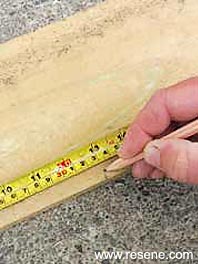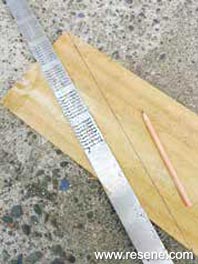Pyramid planter
Go vertical with this stylish pyramid planter – perfect for adding some instant height in the garden.
You will need: 4 x 1200mm fence palings, 50mm x 50mm timber (approx. 1.2m), 100mm x 20mm timber (approx. 2.7m), 200mm x 25mm timber (approx. 4.5m), 65mm exterior screws, circular saw, long metal ruler or other straight edge, paint stirrer, paintbrush, pencil, PVA glue (exterior), Resene Waterborne Woodsman tinted to Resene English Walnut, sandpaper (coarse), screwdriver.
Top tips: To easily rule a 45-degree line use the back of a regular crosscut handsaw – the handle of most have a built-in guide for ruling 90 and 45 degree angles.
Take care to drill each 65mm screw in at an angle to ensure the point doesn’t protrude out through the back of the timber.
To get the look: Mark stained the background raised bed with Resene Waterborne Woodsman tinted to Resene Japanese Maple.
Handy hint: As well as the bought 50mm x 50mm timber and fence palings, we used a selection of reclaimed wood from disassembled pallets and other wooden crates. For a more permanent structure, however, it would pay to use only appropriately treated timber.
Planting ideas: We used a selection of pelargoniums but this planter could also be used for seasonal colour, ornamental grasses, herbs, salad vegetables, strawberries, or even small succulents.

 Step one
Step one
Make a mark 330mm from one end of one of the fence palings.
 Step two
Step two
Rule a diagonal line from this mark to the opposite corner, as shown.
 Step three
Step three
Repeat with the other three fence palings and then cut along these lines with the saw. Smooth rough edges with sandpaper.
 Step four
Step four
Place the 50mm x 50mm piece of timber on a flat surface and place two of the fence palings into position, as shown. Rule a horizontal cutting line along the base using the metal ruler. Repeat with the other two fence palings.
 Step five
Step five
Saw these pieces of timber to size using the ruled lines as a cutting guide. Smooth rough edges with sandpaper.
 Step six
Step six
Assemble the four pieces of fence paling and the central 50mm x 50mm support into a ‘pyramid’ frame, as shown. Fix securely with PVA glue and screws.
 Step seven
Step seven
Set the blade of the circular saw to 45 degrees and cut a piece of 100mm x 20mm timber to fit along one side of the base (ours measured 665mm). Smooth rough edges with sandpaper.
 Step eight
Step eight
Fix this piece of timber into position, as shown, using screws and PVA glue.
 Step nine
Step nine
Repeat steps seven and eight to complete the remaining three base supports, as shown.
 Step ten
Step ten
Make a mark 150mm from the base of one of the angled supports and rule a 45 degree line upwards across the angled support, as shown. Rule a corresponding 45 degree line across the face of the opposite support.
 Step eleven
Step eleven
Measure the distance between these two ruled lines at the back of the two supports and then the distance between the two ruled lines at the front of the two supports. Use these measurements to cut a trapezoid shape from the 200mm x 25mm timber. (The circular saw blade should still be set at 45 degrees.) Smooth rough edges with sandpaper.
 Step twelve
Step twelve
Place this piece of timber into position, aligning it with the ruled lines, and fix with PVA glue and screws.
 Step thirteen
Step thirteen
Repeat steps eleven and twelve to complete the first tier of angled walls, as shown.
 Step fourteen
Step fourteen
Using the same technique described in steps ten to thirteen, create a second tier of angled walls – although this tier should be 250mm higher than the previous tier.
 Step fifteen
Step fifteen
Again, using the same technique described in steps ten to thirteen, create a third tier of angled walls – this tier should also be 250mm higher than the previous tier. Allow glue to dry.
 Step seventeen
Step seventeen
Apply two coats of Resene Waterborne Woodsman tinted to Resene English Walnut to the planter, allowing two hours for each coat to dry.
 Finished project
Finished project
A selection of pelargoniums...
 Step one
Step one  Step two
Step two  Step three
Step three  Step four
Step four Step five
Step five  Step six
Step six  Step seven
Step seven  Step eight
Step eight  Step nine
Step nine Step ten
Step ten Step eleven
Step eleven Step twelve
Step twelve Step thirteen
Step thirteen Step fourteen
Step fourteen Step fifteen
Step fifteen Step seventeen
Step seventeen Finished project
Finished project